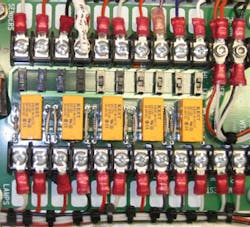Five Things to Think About Before Using Hardwired Controls
You can find these devices in discrete and process industries, on the plant floor in the manufacturing environment and even in commercial and consumer applications such as gate controls, vending machines and amusement equipment.
They work just fine, doing their assigned tasks as required so what’s the problem? At least, that’s the question many OEMs are asking as they try to justify continuing to use these legacy control designs to meet evolving business objectives.
“These small controls are everywhere,” says Paul Ruland, spokesperson for Siemens Energy & Automation. “And this poses a quandary for end users faced with changing needs or the risk of obsolescence.
At the end of the day the answer to that critical question is simple and highly significant considering the current state of the economy, adds Ruland. They cost more than the alternatives. They cost more to install, to run and to support.
The best alternative, according to a white paper by ARC analysts Himanshu Shah and Craig Resnick titled Five Things to Think About Before Using Hardwired Controls Again, is the programmable relay.
Programmable relays are microprocessor-based controllers with similar capabilities to Programmable Logic Controllers (PLC) with built-in timers, counters and compare instructions, only they are much more easily programmed – making them easier to install and use, much like the hardwired controls they are replacing.
“In the past, OEMs were forced to choose between simple hardwired controls or internally developed and designed custom controllers for their products,” wrote Shah and Resnick. “In either case, very small systems often could not justify the cost of a PLC, or similar controller, until the programmable relay became available.”
Programmable relays are already seeing use in many industries and are seeing adoption in new applications that previously were cost, technology or size prohibited. For example, programmable relays are replacing those aforementioned hardwired timers, counters and cube relays in applications ranging from ventilator controls in office buildings to sequential control systems for industrial manufacturing.
“Many OEMs are migrating their traditional hardwired control designs toward alternative control systems,” wrote the analysts. “For most OEMs, programmable relays can serve as a very cost effective controller for their products due to not only their increased flexibility and reduced physical size, but also because they offer a lower total cost solution with quicker assembly and installation compared to hardwired controls.”
ARC identified five reasons to choose a programmable relay over hardwired controls:
1) Number of Components: Because programmable relays come with common control functions built-in you don’t have to buy separate devices for timing, counting, etc. A single programmable relay can replace multiple timers, counters and cube relays, reducing the number of required components cutting the cost of the new system.
2) Enclosure Size: A single programmable relay takes up a lot less space meaning you can reduce the size of the electrical enclosure you are using, cutting the installation footprint on any controller equipment, freeing up space. Additionally, because the enclosures are generally made of steel, their price is subject to the volatility of the commodities market so you reduce your cost exposure.
3) Engineering and Configuration Effort: They make it easier to design and configure the machine or line. Rather than trying to figure out where you are going to put multiple hardwired devices, how you are going to power and control them you only have to do this once. Additionally, simple programming commands based on hardwired principles eliminates the need for an engineer or trained programmer to configure it.
4) Manufacturing and Installation Cost: Installing, wiring and testing a single programmable relay with a built-in power supply takes a lot less time than traditional wired controllers. Additionally, fewer connections mean fewer possible points of failure increasing reliability when operating. Says ARC, “Assembly and testing of a system with hardwired controls requires a significant amount of interconnect wiring between individual devices, increasing material costs such as wire, terminal blocks, wire duct, DIN rail, etc., and labor costs.”
5) Maintenance and Modification: Using programmable relays reduces the amount of time required for commissioning and maintenance. The integrated display and keypad on a programmable relay provides alarm messages and I/O status simplifying troubleshooting and often eliminating the need for a multi-meter or logic probe, which is used to maintain hardwired controls.
Ruland estimates that programmable relays reduces component costs by up to 30 percent on systems using >5 hardwired devices and installation and manufacturing cost by more than 50 percent.
“With pressure mounting to increase production while reducing waste, energy costs, and maintenance downtime, companies are looking for any advantage they can get,” he says. “Programmable relays provide a clear step up from the legacy hardwired systems they are so reliant on.”

